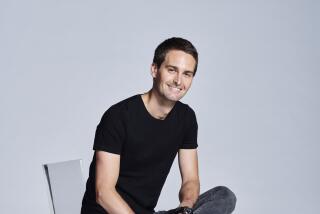How I Made It: Pinterest co-founder Evan Sharp had to learn how to lead
Evan Sharp is co-founder and chief product officer of Pinterest, a web-based company with more than 1,500 employees that allows users to “pin” media they like from across the internet to virtual boards. After building the service in 2009 and launching it a year later, he has seen the company grow to more than 250 million active monthly users who pin cookie recipes, wedding ideas, dream vacations and the like.
A man, a Mac
Growing up in Pennsylvania, Sharp was drawn to computers and design. Although he wasn’t raised in a very technological household — both his parents were park rangers — his father was a Macintosh hobbyist and always kept a computer around.
“I spent an unreasonable amount of time drawing things on the computer and trying to mess up the computer,” Sharp said. “I developed this passion for building and structuring things.” That passion remained as he held down jobs as an umpire, a Subway sandwich artist and an overnight fried food processor at a pretzel factory.
The email
In 2009, while studying architecture at Columbia University, he received an email from Facebook asking if he’d be interested in interviewing for a job. He flew to San Francisco, and soon after, Facebook offered him a product designer position.
He had a few months to spare before he started, so he used the time to build Pinterest with his friend and co-founder, Ben Silbermann. The duo designed it, coded it and then shelved it as a passion project.
Growing restless
Facebook doubled its employee count while Sharp was there, growing from about 800 to 1,500, in his estimation. He helped as the company transitioned from desktops to phones, but he always had other aspirations on his mind.
“The whole time, all I wanted to do was go work on Pinterest. After a year, I decided that if I love it that much, I should be working there full time,” Sharp said. In 2011, he swapped being a team player at a successful company with a certain future to being the top dog of an aspiring company with an uncertain one.
Early struggles
“It took a while for us to take off,” Sharp said. “If we were more responsible as entrepreneurs, we would’ve pivoted to something else.”
In the early days, Sharp and Silbermann had to figure out the type of company they wanted to be, a process that led them to model Pinterest after their own personalities: introverted, optimistic and positive. Seven years and 175 billion pins later, those values still stand.
“Pinterest is a positive, optimistic place online. You spend time on what you want, not what you share with others,” he said. Consequently, Sharp shuns the “social media” label. Facebook, Twitter, Snapchat and Instagram are about what’s happening right now, he said, but Pinterest focuses on its users’ futures.
Learning to lead
As head honcho, Sharp found himself second-guessing his ability to lead. He had always been a creator, not a manager.
“We hired all these great managers that were doing a great job, and I looked at myself in contrast to them,” he said. “They were all so professional and competent.” He wondered if he was good at starting companies but not at running them.
His perspective quickly changed when he met Jony Ive, Apple’s chief design officer. Like Sharp, Ive was creative, emotional and, most important, not the stereotypical leader featured in the Harvard Business Review. “I thought, ‘Wow, I could actually be the best.’ Someone like me could be really amazing.”
Noncompetitive nature
Sharp is familiar with Silicon Valley’s competitive culture. However, he has never embraced the idea that he needs to beat out other companies.
“If we’re not doing better, it’s almost always our own inability to execute, not because someone else is stealing our market share or something,” he said.
Feedback
Pinterest’s success is predicated on building an environment where its users can be happy — a pleasant, personal corner of the web where the future matters more than the present or past. To avoid the feedback loop of Silicon Valley, Sharp takes trips throughout the country to stay in touch with what pinners want. Over dinners in Ohio, Kentucky, Georgia and beyond, he asks people how and why they’re using Pinterest.
“If you do it enough, you start to see these patterns and experience them in full sensory reality. You triangulate, in addition to behavioral data and user research, what impact we’re having and why it matters to people,” Sharp said.
By design
Over time, Sharp’s design-oriented mind has started to view the apps people use not as products or tools but as environments. As an architect, he feels great responsibility when forming the place where people spend their time. “If you’re designing a hammer, it’s clear that it should hit a nail,” Sharp said. “But when designing a home, it’s much more nuanced. You have to make sure there are qualities that nurture and enrich human life.”
For Pinterest, that means asking questions beyond whether the app is pretty and easy to use.
“I’m interested in shaping the way people relate to things instead of just shaping the form of things. Part of that means shaping good emotional outcomes for our users.”
Personal
Sharp, 35, lives with his wife, Christina, in San Francisco. They’re expecting a daughter in November.
Twitter: @jflem94
More to Read
Inside the business of entertainment
The Wide Shot brings you news, analysis and insights on everything from streaming wars to production — and what it all means for the future.
You may occasionally receive promotional content from the Los Angeles Times.










